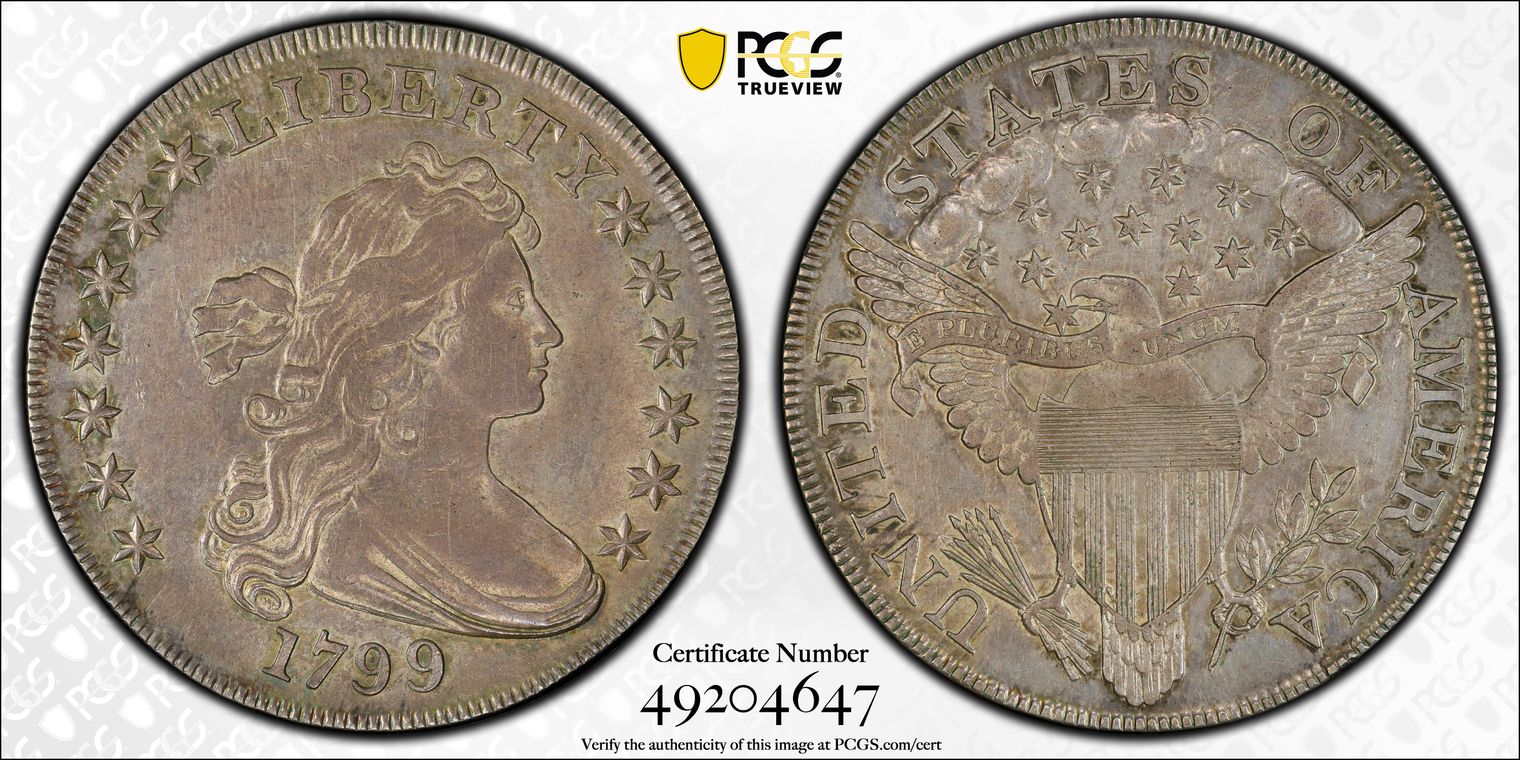1799 $1 BB-167 AU50 认证号49204647, PCGS号40058
专家评论
Q. David Bowers
The following narrative, with minor editing, is from my "Silver Dollars & Trade Dollars of the United States: A Complete Encyclopedia" (Wolfeboro, NH: Bowers and Merena Galleries, Inc., 1993). Note: the Notable Specimens list should be used with caution - it has been updated in my 2013 edition of "The Encyclopedia of United States Silver Dollars 1794-1804."Bolender 14, Haseltine 14
OBVERSE 10: Two raised die flaws in field, or "tears, "before eye, one very clear. The smaller is in the field close to and opposite to the bottom of the forehead, just above the bridge of the nose. The larger and by far the most notable is in the field about 40% of the way from the nose bridge to star 9. On some lower grade coins these "tears" are not visible. Last star near bust (about 0.5 mm.) and a little closer than 8th star is to Y. 7th star farther from L, and first star nearly 2 mm. froth curl. Stars 11, 12, and 13 point to spaces between denticles. Small die flaw in field to left of ray of star 8 closest to bottom of Y. The last 9 is about as near bust as star 8 is to Y. Die flaw from outer point of 10th star. Same obverse die used for BB-168. All examples are weakly struck on the hair.
Obverse die used to strike 1799 BB-167 (earlier use) and BB-168 (later use).
REVERSE 0: Die flaws under AM, between two lower stars just back of eagle's head, between the F in OF and the wing tip, and one below the D in UNITED. Point of star touches point of lower part of eagle's beak. Another point of same star points to space between Band U of PLURIBUS. Far right edge of A is over junction of clouds 3 and 4. Leaf points to center of I in AMERICA. A does not touch feathers of right wing, but is near 3rd feather. Die crack through upper part of AME.
Reverse die used to strike 1799 BB-167 (earlier use) and BB-169 (later use).
DIE STATES:
Die State I: Perfect dies. No obverse flaws. No reverse cracks. May not exist.
Die State II: Obverse with "tears" in field before face. Reverse with flaws below first A of AMERICA, slanting downward to halfway below M. Common die state.
Die State III: Obverse as above. Reverse now with crack connecting tops of AM and extending upward toward wing. The most common die state.
Die State IV: Obverse as above. Reverse now with crack connecting tops of AME. As described by Bolender for BB-167. Scarcer than preceding.
COLLECTING NOTES: 1799 BB-167 is in the middle range of varieties of this year so far as availability is concerned. About 400 to 700 are known. Most examples are in grades of Fine and VF, with an occasional EF. Any coin finer than that is truly exceptional. This is another of many early dollar varieties that is readily available in VF grade but becomes a rarity if finer.
NOTABLE SPECIMENS:
Chapman Specimen. MS-60. Henry Chapman. M.H. Bolender Collection, 1952:115. "Die flaws in field before eye will identify this variety. Reverse: die crack through top of AME. Unc., strong impressions, reverse struck somewhat off center to right as usual with this variety. Mint lustre."
Krugjohann Specimen. AU-58. Bowers and Ruddy Galleries, Krugjohann Collection, 1976:619. "Brilliant Unc. with some very light rubbing (cabinet friction), mainly on the obverse. Exceptional fields and a nice strike."
Baldenhofer Specimen. AU-50. W.G. Baldenhofer Collection. Farish-Baldenhofer Sale (Stack's). AJ.Ostheimer, 3rd Collection. 1975 ANA Convention Sale (Superior):94.
Getty Specimen. AU•50. Bowers and Ruddy Galleries, 1977:536. "A choice well-struck early silver dollar. Just the lightest wear on the higher areas. Nearly full original mint frost in the fields."
Getty Specimen (another). AU-50. Bowers and Ruddy Galleries, Getty Collection, 1977:1695. "Sharply struck and well defined AU. Beautiful light lilac-gray patination."
Gross Specimen. AU-50. New England Rare Coin Galleries, May 1979. "Toned, attractive, original color. Traces of prooflike surface." Sold to the following. Yolanda Gross Collection.
Mount Vernon Specimen. EF-45. Superior Galleries, Mount Vernon Collection, 1976:817. "Die flaws before the eye. EF-45+. Partly lustrous with pale lilac and golden toning. Excellent surfaces with minimal handling marks."
Kagin Specimen. EF-45. Kagin's, NASC Convention Sale, 1979:529. "EF-45 with original bluish gray toning, usual slightly dished reverse die, lint marks, faint lines in field."
Carmichael Specimen. EF-45. Superior Galleries, Hoagy Carmichael Sale, 1986:1188. Superior Galleries, A. Bernard Shore Collection, 1988:2211. "EF-45+. Obverse and reverse die flaws as described by Bolender. Sharply struck and original with light golden centers changing to golden iridescence at borders. The centering is excellent with all the denticles sharp; some lustre is visible in the protected areas. A few small marks on the obverse."
PCGS #
40058
设计师
Robert Scot
边缘
Lettered: HUNDRED CENTS ONE DOLLAR OR UNIT
直径
40.00 毫米
重量
27.00 克
铸币数量
423515
金属成分
90% Silver, 10% Copper
更高评级数量
2
评级较低的钱币数量
14
地区
The United States of America
价格指南
PCGS 数量报告
拍卖 - PCGS 评级的
拍卖 - NGC 评级的
状况普查 了解更多
|
#1 MS63 estimated grade
Stack's 3/2005:2222, $57,500 |
|
#1 MS63 estimated grade
Stack's 10/2006:2850, $43,125 |
|
#3 MS62 PCGS grade
American Numismatic Rarities 1/2004:144, $43,700 |




















